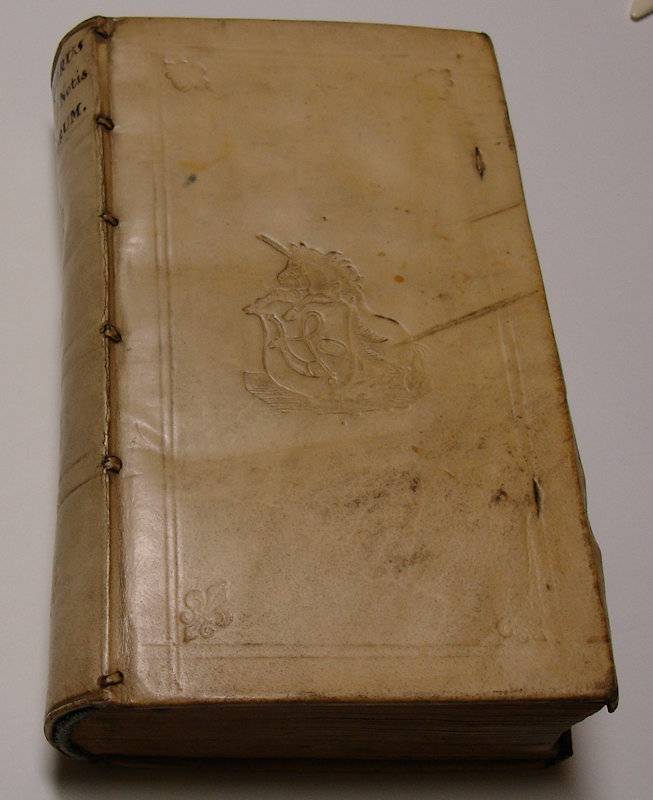FLORUS.
L.A. Florus cum notis integris Cl. Salmasii et selectissimis Variorum, accurante S.M.D.C. Additus etiam L. Ampelius ex Bibliotheca Cl. Salmasii.
Amsterdam (Amstelodami), Ex officina Elzeviriana, 1674.
8vo. (XVI),588,(108 index),46,(2 blank) p. Overlapping vellum 20.5 cm (
Ref: STCN ppn 842457577; Willems 1490; Berghman 2064; Rahir 1598; Schweiger 2,361; Ebert 7683. Spoelder p. 613, Hoorn 2) (
Details: Prize copy, without the prize. 6 thongs laced through both joints. Blind stamped fleurs de lis on the back. Boards with blind double fillet borders, in the center of them the coat of arms of the city of Hoorn. Engraved title, depicting a throned goddess Roma on a pedestal, allegorical figures, representing Europe, Asia and Africa offer her their treasures; in the foreground Tibur, and little Romulus and Remus and their shewolf) (
Condition: Prize gone. vellum age-toned, slightly soiled and scratched. All 4 textile fastening ties gone. Front flyleaf gone. Title slightly worn. Name on the front pastedown) (
Note: 'Favourite school-book in the 17th century'. This is the chief work of the Roman historian Lucius Annaeus Florus, who lived at the beginning 2nd century AD. It is an abridgement of Roman history with special reference to the wars waged up to the age of Augustus. Florus 'shows a certain literary gift, marred, however, by a strong tendency to rhetoric. His brevity often entails obscurity, though he sometimes produces a felicitous epigram. (...) As an historian he is often inaccurate in both chronology and geography, but the work as a whole achieves a limited success as a rapid sketch of Roman military history. It was a favourite school-book in the 17th century'. (OCD, 2nd ed. p. 442)
§ This edition is a socalled 'Variorum edition'. It offers a 'textus receptus' which is widely accepted, accompanied with the commentary and the annotations of various specialists, taken or excerpted from earlier useful, normative or renewing editions. Editions like these, 'cum notis Variorum', were useful, but never broke new ground. The production of these sometimes overloaded editions was the specialty of Dutch scholars of the 17th and 18th century. The compilers seldom were great scholars, but often hard working schoolmasters. Their involvement in publishing a new edition was limited to the necessary, but ungrateful task of the beast of burden.
§ This Variorum edition was produced by, so the title says, S.M.D.C, that is by Cornelis Schrevelius, who took his doctoral degree in Paris as a Doctor of Medicine in 1627. Hence S.M.D.C., that is Schrevelius Medicus Doctor Cornelis. He taught classics at the Schola Latina at Leiden, where he had been raised himself. In 1642 he succeeded his father, Theodorus Schrevelius, as the rector (Moderator) of the school. He died in 1664, a few days after having completed an edition of Claudian. He raised at least 11 kids, and fell victim to the plague. (A.M. Coebergh van den Braak, Meer dan zes eeuwen Leids Gymnasium, Leiden, 1988, p. 47/55)
§ This edition of 1674 is a reissue of the Elzevier edition of 1660. The commentary of the French scholar Claude Saumaise, latinized as Claudius Salmasius, 1588-1653, was adopted from the Elzevier edition of 1638, which edition included also the 'editio princeps' of the 'Liber Memorialis' of Lucius Ampelius. Salmamius was since 1631 professor at the University of Leiden) (
Provenance: On the front pastedown in ballpoint: 'Lennart Hakanson', 1939-1987, professor of Latin at the university of Uppsala) (
Collation: *8, AQ-2Z8, 3A4 (leaf 3A4 blank)) (Photographs on request)
Book number: 130055 Euro 225.00
Keywords: (Oude Druk), (Rare Books), Dutch imprints, Elzevier, Latin literature, Prize copy, Prize copy Hoorn, Roman history, Salmasius, Schrevelius, Variorum, antike altertum antiquity, römische Geschichte, römische Literatur
 FLORUS.
FLORUS.